I thought catching redfish was everything. Stalking reds. Sneaking
up on a pod, a pair, a single or a tailing red takes patience and
stealth. They are easy targets in contrast to their surroundings.
Molten cooper forms against muted green and blue grass. Hooking
a redfish is an angler's dream-come true. On the first explosive
run your heart pounds as he spools into your backing. Out 60 yards
then straight back at you. When he sees the boat he will angle
off, spooling more line. The redfish makes another run. Just
when you think you have him, he turns and makes another. This
can go on for 30 minutes or longer. Even an 18-inch red will
rate a high-five. Holding and keeping that rod tip high,
watching and feeling the rod bend, reeling and slacking off,
you can feel his strength and power, and it is a great feeling.
You'll feel exhausted and swear that life can't get any better.
But, it can.
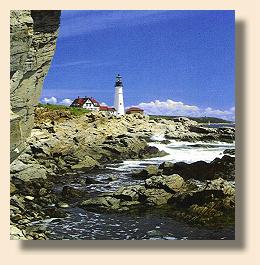
I met Captain John Ford of Portland Guide Service (Maine) on a clear cool
August morning. Everything changed when I hooked up my first
striper. Stripers are an awesome fighting fish. They even
look like redfish, but much stronger. By comparison, they crash
flies like snook or jacks, pull like baby tarpon, run and line you
like bones and redfish. Their mouths are like reds and bones with
crusher plates nestled in their throats. But unlike reds they
have no lip teeth, so you can hold them with a thumb in their mouth.
Muster all your strength to hold the rod when they dive. They rise
and run like torpedoes slicing and dicing the waves, making erratic
moves to shake the hook. You have not really fished until you've
hooked a striper on a fly.
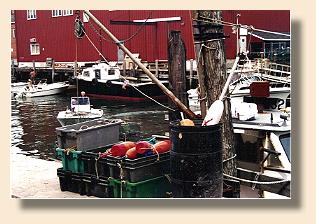 He looked at me and just shook his head. I had on two shirts, a
blue fleece sweater under a heavy green slicker, hat, long pants
and wool socks. Best ingredients for floating in water we use
in Florida to make ice-cubes. I couldn't believe how cold it
was – mid-fifty's. I'm from Florida where the average temperature
on a summer morning is 78 degrees. (Even at 4:45 am.) I had a
little adjusting to do. Capt. John had the coffee and it did
help.
He looked at me and just shook his head. I had on two shirts, a
blue fleece sweater under a heavy green slicker, hat, long pants
and wool socks. Best ingredients for floating in water we use
in Florida to make ice-cubes. I couldn't believe how cold it
was – mid-fifty's. I'm from Florida where the average temperature
on a summer morning is 78 degrees. (Even at 4:45 am.) I had a
little adjusting to do. Capt. John had the coffee and it did
help.
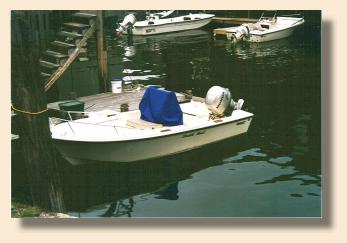 The floating dock was five-feet below the street. There
were stairs leading to, and ending in the water. A side step
put you on the dock. Here the tide runs from 9 to 11 feet. This
makes getting to your boat a challenge. Figure these tides would
cover about 40% of Florida. We set out armed with two fly rods:
an 8wt Loomis with 9wt Fly Line and a 9wt Sage RPLXi with Lead-Core
Shooting Taper, each rig with fluorocarbon shock tippet. Our flies
consisted of your typical grocery flies (large bunkers and sand lance)
and a few of my favorites for Reds and Snook.
The floating dock was five-feet below the street. There
were stairs leading to, and ending in the water. A side step
put you on the dock. Here the tide runs from 9 to 11 feet. This
makes getting to your boat a challenge. Figure these tides would
cover about 40% of Florida. We set out armed with two fly rods:
an 8wt Loomis with 9wt Fly Line and a 9wt Sage RPLXi with Lead-Core
Shooting Taper, each rig with fluorocarbon shock tippet. Our flies
consisted of your typical grocery flies (large bunkers and sand lance)
and a few of my favorites for Reds and Snook.
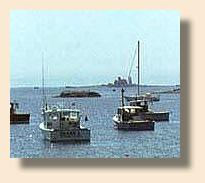 Portland harbor is a busy place in the early morning. Commercial
traffic from trawlers, shrimpers, long-liners, ferry boats, lobster
boats and tugs making way in the quiet of the morning. Cruise liners,
container ships and oil tankers are lined up in Fore River near
Commercial Street. The 90-horse Honda 4-stroke quietly purred.
I hunkered down and drank my coffee - thankful for the day at hand.
Portland harbor is a busy place in the early morning. Commercial
traffic from trawlers, shrimpers, long-liners, ferry boats, lobster
boats and tugs making way in the quiet of the morning. Cruise liners,
container ships and oil tankers are lined up in Fore River near
Commercial Street. The 90-horse Honda 4-stroke quietly purred.
I hunkered down and drank my coffee - thankful for the day at hand.

We pushed ahead into Casco Bay. The 17-foot center console Mako
gave us a solid, dry ride in a moderate chop as we inched our way
to the outer boundary of the no-wake zone. In the low light I
could just make out the movement of seals swimming among thousands
of lobster markers. Seal love lobsters and will go to great lengths
including raiding traps to get them. Stripers like them to. Sometimes
lobster fisherman will find stripers in their traps. Stripers will
eat almost anything when they are hungry, which is most of the time.
Stripers migrate to Maine during the summer from Chesapeake Bay,
then return south in the fall. They migrate north along the
Atlantic seaboard making their way to the Casco Bay in search
of food consisting of Pollock, mackerel, anchovies, pilchards,
menhaden, crabs, lobster and grass shrimp. As long as they have
cool, fast moving water and plenty of bait, stripers will be
ravenous and plentiful. They are found outside along the ledges
where drops of twenty feet or more are common, or in the river
flats where fast dropping tide traps baitfish for easy pickings.
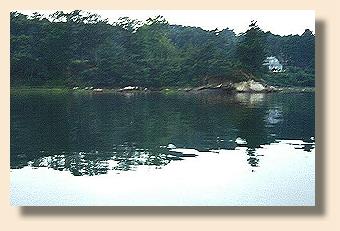
John pointed out landmarks as we motored past Fish Point and Halfway
Rock, past Mackworth Island and The Brothers to a quiet area near
Yarmouth. John's boat, The Double Haul, rounded a bell buoy as we headed north
to a beautiful cove. The cove is flanked by huge ledges on the
north and south and by tall pines that break the wind. Water depth
is five feet with a grassy bottom that holds all types of bait and
grass shrimp.
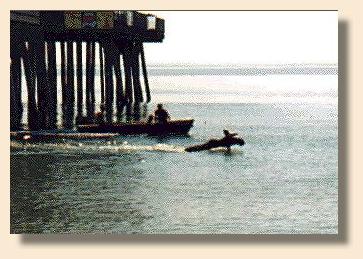
High tide gives good cover for these marauding predators. Stripers
are known to strike pray as the tide starts to fall. We positioned
ourselves parallel to the grass line about 75 feet out on a drift
past a large boulder. You can see the distinctive tail swirl as
stripers patrol along the grass edge. Even in the deeper water
they move about a foot below the surface. Their unmistakable
horizontal black stripes are easy to spot as they accelerate
past us, about fifty feet away. One. Three. More stripers
run past oblivious to our presence, even when Capt John started
the engine to reposition Double Haul.
I cast a yellow Hot Lips imitation on 9wt Slime Line. Out sixty
feet and 11-o'clock the sinking line pulls the fly down and I start
the strip. The retrieve is fast, since stripers like moving baitfish.
But, the cast is also blind, since it is too dark to sight fish.
On the third cast, a striper and four of his pals follow the fly
to within ten feet of Double Haul. What an awesome sight. A fourth
cast brings another striper who repeatedly strikes the fly with its
tail. "He's trying to kill the fly," says John. Three or four
successive slaps with his tail and the striper backs off. I've
never seen a game fish do this. But this is common for stripers
hitting baitfish near the surface.
So I stopped stripping. The line slackened and as I started to
mend the line the striper came back and gobbled down the fly.
Now he makes an explosive run for the boulder.
"We've got to turn him or he'll wrap the line around the rock."
Keeping the rod low, I pulled hard, turned the fish and reeled him
back towards the boat. In a short time the 21-inch 'schoolie' is
boated, photographed and released. Compared to a redfish, and
one of almost any size, it would take a lot more to get him to
the boat. Stripers don't seem as paranoid as redfish. Once to
the boat, they seem relatively easy to handle. They seem almost
docile, as Capt John demonstrated by putting his thumb in the
stripers mouth.
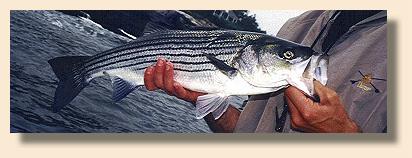
We had a ball catching and releasing schoolies and we could have
spent many more hours there. But it was time to move on and try
a few of Capt. John's other favorite areas. Heading southeast,
we passed Cow Island on our way into Hussy Sound. I noticed the
swells as we passed more lobster buoys. These buoys are everywhere.
Lobsters are prolific breeders and grow quickly in the cool ocean
water. With the tide going out and the wind blowing up from the
south, it made for some interesting seas.
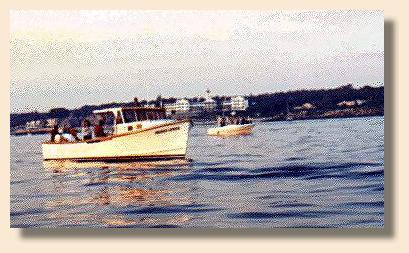 The waves came in sets of four. There was a lull between the sets.
Rising up and then falling,it felt like we were suspended, by
magical straps, holding us in place while the ocean passed beneath
us. This rolling water is prominent outside the protection of the
harbor. I've been in water like this but only in storms out of
Ponce Inlet. It's an uneasy feeling if you aren't used to it.
As John mentioned a few times, "my brother loves to stand on the
bow and cast flies into the froth after a wave passes to the ledges."
It takes a little getting used to. Figure you're on a hydraulic
elevator that is hoisting you up and then letting you back down.
The waves came in sets of four. There was a lull between the sets.
Rising up and then falling,it felt like we were suspended, by
magical straps, holding us in place while the ocean passed beneath
us. This rolling water is prominent outside the protection of the
harbor. I've been in water like this but only in storms out of
Ponce Inlet. It's an uneasy feeling if you aren't used to it.
As John mentioned a few times, "my brother loves to stand on the
bow and cast flies into the froth after a wave passes to the ledges."
It takes a little getting used to. Figure you're on a hydraulic
elevator that is hoisting you up and then letting you back down.
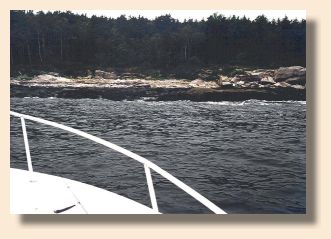 You can see the wave recede and the ledges exposed about forty
feet below. It is unbelievable. That's where the stripers are
lurking and hiding in cover around the rock ledges. Even with
these conditions, stripers are prolific in the rolling water.
We worked an area along the cliffs. Out only 100 yards from
the rocks, Captain John cut the engine. "We'll be ok. With
the tide and the wind, we'll just bob here in place." I noticed
a blue and white lobster buoy near by. John was right we didn't
really move much. He did start the engine a few times to position
us better. All in all, we just stayed where he put us. John landed
a nice striper as we bobbed up and down in the eight-foot swells.
You can see the wave recede and the ledges exposed about forty
feet below. It is unbelievable. That's where the stripers are
lurking and hiding in cover around the rock ledges. Even with
these conditions, stripers are prolific in the rolling water.
We worked an area along the cliffs. Out only 100 yards from
the rocks, Captain John cut the engine. "We'll be ok. With
the tide and the wind, we'll just bob here in place." I noticed
a blue and white lobster buoy near by. John was right we didn't
really move much. He did start the engine a few times to position
us better. All in all, we just stayed where he put us. John landed
a nice striper as we bobbed up and down in the eight-foot swells.
Time to move on. Off to the races, I mean flats. I love fishing
flats. Maine has really beautiful flats. They can be found anywhere
that rivers empty into the bay or island creeks edged with tall grass.
As you can imagine it's crystal clear even in eight feet of water.
You can see the bottom, the shells and sand. As we motored southwest
towards Long Island and Luckse Sound, the sun was just coming up.
We moved across rolling water heading for Whitehead Passage, past
Trotts Rock, north again to Little Diamond and to the secret flats
known only to Captain John.
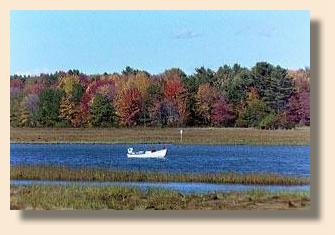 Rays of sunlight spread out across the sea forming a wide triangle
from a narrow slit on the horizon. The bell buoy glistened in the
morning sun. I felt the rays penetrate my jacket. My body picked
up its warmth and I forgot where I was. It's hard to believe that
you can fish a shoreline edged by sheer cliffs and out-croppings
of rocks and ledge. Houses line the tops of the rocky ledges.
In some areas the tall pines seem to rise out of the sea. This
coastline's beauty is overwhelming. We fished the south side
of Portland Head Light and caught many stripers there.
Rays of sunlight spread out across the sea forming a wide triangle
from a narrow slit on the horizon. The bell buoy glistened in the
morning sun. I felt the rays penetrate my jacket. My body picked
up its warmth and I forgot where I was. It's hard to believe that
you can fish a shoreline edged by sheer cliffs and out-croppings
of rocks and ledge. Houses line the tops of the rocky ledges.
In some areas the tall pines seem to rise out of the sea. This
coastline's beauty is overwhelming. We fished the south side
of Portland Head Light and caught many stripers there.
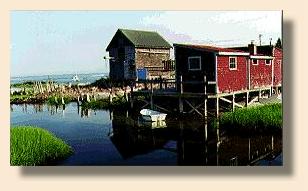
Above the dark blue water, the buoy appeared like a big chunk
of gold, like the sun had recast its massive structure. I came
back to reality quickly as a touch of cold over spray hit my face.
We fished a small channel into a flat where the tide was falling
fast. You could see tailing and swirling fish everywhere. I
threw an ultra hair bug and on the second strip hooked up a nice
striper. We were getting a striper for each cast.
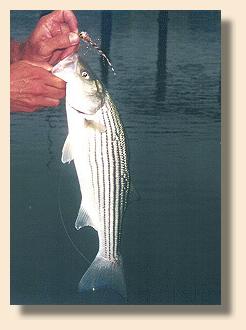 I was absolutely blown away by the action. One striper sucked
the fly all the way down so only the hook eye was sticking out
of his mouth. Removing the hook was easy with the barbs pinched
off. The tide was falling so fast that in ten minutes you could
see the mussel beds. In sixty minutes there was almost enough
time for us to catch four more fish
before we had to back out of the channel.
I was absolutely blown away by the action. One striper sucked
the fly all the way down so only the hook eye was sticking out
of his mouth. Removing the hook was easy with the barbs pinched
off. The tide was falling so fast that in ten minutes you could
see the mussel beds. In sixty minutes there was almost enough
time for us to catch four more fish
before we had to back out of the channel.
Capt. John knows these waters well. That's real important with nine
to ten foot tides. Talk about someone pulling the plug. There just
isn't any comparison to our Florida flats with our drops of less than
two feet. But this fast moving water moves baitfish and attracts
these formidable game fish, including big blues in 20-pound sizes
and up.
Casco Bay is one of the Atlantic's best-kept secrets. A combination
of estuary systems, beautiful rocky coastline and hundreds of uninhabited
islands make up the ideal environment for Striped Bass. Droves of bait
summer here and depending on the time of year you could be sight
fishing shallow flats, throwing six-inch grocery flies (mackerel
and bunker patterns) into crashing surf or tossing top-water flies
into a pod of feeding stripers along an island beach. All of this
within a short boat ride of Portland Harbor.
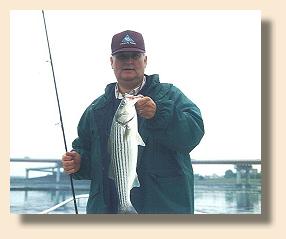
If you want to fish away from the tourist crowds let Capt. John show
you why the locals keep this gem all to themselves. He has been
fishing since he was old enough to hold a fishing rod. He grew up
fishing many saltwater species but at age 31 is obsessed with
chasing "Big Striped Bass" in Maine's most prolific area - Casco Bay.
And now I know why. It is contagious.
Practice catch and release and enjoy our great outdoors.
~ Doug
About Doug:
Capt. Doug Sinclair has relocated from New Smyrna Beach, Florida to
Grantsboro, NC. He specializes in fly-fishing and light tackle charters.
Doug charters the Coastal Carolina area of New Bern or Oriental.
Catch him on the web at
www.flyfishacademy.net or call him at (252) 745-3500.
Doug is also a Sponsor here on FAOL.
|




 I was absolutely blown away by the action. One striper sucked
the fly all the way down so only the hook eye was sticking out
of his mouth. Removing the hook was easy with the barbs pinched
off. The tide was falling so fast that in ten minutes you could
see the mussel beds. In sixty minutes there was almost enough
time for us to catch four more fish
before we had to back out of the channel.
I was absolutely blown away by the action. One striper sucked
the fly all the way down so only the hook eye was sticking out
of his mouth. Removing the hook was easy with the barbs pinched
off. The tide was falling so fast that in ten minutes you could
see the mussel beds. In sixty minutes there was almost enough
time for us to catch four more fish
before we had to back out of the channel.

 He looked at me and just shook his head. I had on two shirts, a
blue fleece sweater under a heavy green slicker, hat, long pants
and wool socks. Best ingredients for floating in water we use
in Florida to make ice-cubes. I couldn't believe how cold it
was – mid-fifty's. I'm from Florida where the average temperature
on a summer morning is 78 degrees. (Even at 4:45 am.) I had a
little adjusting to do. Capt. John had the coffee and it did
help.
He looked at me and just shook his head. I had on two shirts, a
blue fleece sweater under a heavy green slicker, hat, long pants
and wool socks. Best ingredients for floating in water we use
in Florida to make ice-cubes. I couldn't believe how cold it
was – mid-fifty's. I'm from Florida where the average temperature
on a summer morning is 78 degrees. (Even at 4:45 am.) I had a
little adjusting to do. Capt. John had the coffee and it did
help. The floating dock was five-feet below the street. There
were stairs leading to, and ending in the water. A side step
put you on the dock. Here the tide runs from 9 to 11 feet. This
makes getting to your boat a challenge. Figure these tides would
cover about 40% of Florida. We set out armed with two fly rods:
an 8wt Loomis with 9wt Fly Line and a 9wt Sage RPLXi with Lead-Core
Shooting Taper, each rig with fluorocarbon shock tippet. Our flies
consisted of your typical grocery flies (large bunkers and sand lance)
and a few of my favorites for Reds and Snook.
The floating dock was five-feet below the street. There
were stairs leading to, and ending in the water. A side step
put you on the dock. Here the tide runs from 9 to 11 feet. This
makes getting to your boat a challenge. Figure these tides would
cover about 40% of Florida. We set out armed with two fly rods:
an 8wt Loomis with 9wt Fly Line and a 9wt Sage RPLXi with Lead-Core
Shooting Taper, each rig with fluorocarbon shock tippet. Our flies
consisted of your typical grocery flies (large bunkers and sand lance)
and a few of my favorites for Reds and Snook. Portland harbor is a busy place in the early morning. Commercial
traffic from trawlers, shrimpers, long-liners, ferry boats, lobster
boats and tugs making way in the quiet of the morning. Cruise liners,
container ships and oil tankers are lined up in Fore River near
Commercial Street. The 90-horse Honda 4-stroke quietly purred.
I hunkered down and drank my coffee - thankful for the day at hand.
Portland harbor is a busy place in the early morning. Commercial
traffic from trawlers, shrimpers, long-liners, ferry boats, lobster
boats and tugs making way in the quiet of the morning. Cruise liners,
container ships and oil tankers are lined up in Fore River near
Commercial Street. The 90-horse Honda 4-stroke quietly purred.
I hunkered down and drank my coffee - thankful for the day at hand.
 The waves came in sets of four. There was a lull between the sets.
Rising up and then falling,it felt like we were suspended, by
magical straps, holding us in place while the ocean passed beneath
us. This rolling water is prominent outside the protection of the
harbor. I've been in water like this but only in storms out of
Ponce Inlet. It's an uneasy feeling if you aren't used to it.
As John mentioned a few times, "my brother loves to stand on the
bow and cast flies into the froth after a wave passes to the ledges."
It takes a little getting used to. Figure you're on a hydraulic
elevator that is hoisting you up and then letting you back down.
The waves came in sets of four. There was a lull between the sets.
Rising up and then falling,it felt like we were suspended, by
magical straps, holding us in place while the ocean passed beneath
us. This rolling water is prominent outside the protection of the
harbor. I've been in water like this but only in storms out of
Ponce Inlet. It's an uneasy feeling if you aren't used to it.
As John mentioned a few times, "my brother loves to stand on the
bow and cast flies into the froth after a wave passes to the ledges."
It takes a little getting used to. Figure you're on a hydraulic
elevator that is hoisting you up and then letting you back down.
 You can see the wave recede and the ledges exposed about forty
feet below. It is unbelievable. That's where the stripers are
lurking and hiding in cover around the rock ledges. Even with
these conditions, stripers are prolific in the rolling water.
We worked an area along the cliffs. Out only 100 yards from
the rocks, Captain John cut the engine. "We'll be ok. With
the tide and the wind, we'll just bob here in place." I noticed
a blue and white lobster buoy near by. John was right we didn't
really move much. He did start the engine a few times to position
us better. All in all, we just stayed where he put us. John landed
a nice striper as we bobbed up and down in the eight-foot swells.
You can see the wave recede and the ledges exposed about forty
feet below. It is unbelievable. That's where the stripers are
lurking and hiding in cover around the rock ledges. Even with
these conditions, stripers are prolific in the rolling water.
We worked an area along the cliffs. Out only 100 yards from
the rocks, Captain John cut the engine. "We'll be ok. With
the tide and the wind, we'll just bob here in place." I noticed
a blue and white lobster buoy near by. John was right we didn't
really move much. He did start the engine a few times to position
us better. All in all, we just stayed where he put us. John landed
a nice striper as we bobbed up and down in the eight-foot swells. Rays of sunlight spread out across the sea forming a wide triangle
from a narrow slit on the horizon. The bell buoy glistened in the
morning sun. I felt the rays penetrate my jacket. My body picked
up its warmth and I forgot where I was. It's hard to believe that
you can fish a shoreline edged by sheer cliffs and out-croppings
of rocks and ledge. Houses line the tops of the rocky ledges.
In some areas the tall pines seem to rise out of the sea. This
coastline's beauty is overwhelming. We fished the south side
of Portland Head Light and caught many stripers there.
Rays of sunlight spread out across the sea forming a wide triangle
from a narrow slit on the horizon. The bell buoy glistened in the
morning sun. I felt the rays penetrate my jacket. My body picked
up its warmth and I forgot where I was. It's hard to believe that
you can fish a shoreline edged by sheer cliffs and out-croppings
of rocks and ledge. Houses line the tops of the rocky ledges.
In some areas the tall pines seem to rise out of the sea. This
coastline's beauty is overwhelming. We fished the south side
of Portland Head Light and caught many stripers there.
